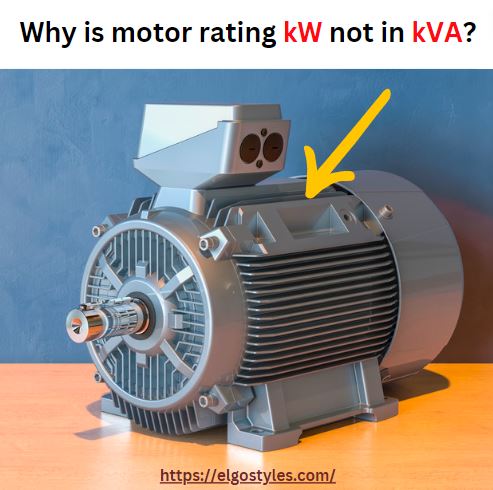Answer:
Motor rating in kilowatts (kW) represents real power, which is the actual power consumed for mechanical work. Kilovolt-amperes (kVA) would include both real power and reactive power, but for motors, the emphasis is on real power.
Reasoning:
Real Power vs. Apparent Power: Kilowatts (kW) represent real power, reflecting the actual energy consumed for mechanical output. Kilovolt-amperes (kVA) include both real and reactive power, but in motors, reactive power is less relevant.

Efficiency Consideration: Motor efficiency is calculated based on real power (kW), emphasizing the portion of power converted into useful work, while kVA includes reactive power that doesn’t contribute to mechanical output.
Practicality and Clarity: Motor rating in kW provides a clear and practical indication of the power required for effective motor operation, simplifying design, selection, and operational considerations.
FAQs:
Q: What does motor rating in kilowatts (kW) signify?
A: Motor rating in kW represents the actual power consumed for mechanical work, known as real power.
Q: Why not use kilovolt-amperes (kVA) for motor rating?
A: Motor efficiency is based on real power (kW), and for motors, the emphasis is on the power converted into useful work.
Q: Does motor rating in kW consider reactive power?
A: No, motor rating in kW specifically reflects real power, excluding reactive power which is less relevant for motors.
Q: How is motor efficiency calculated using kW?
A: Motor efficiency is the ratio of useful output power (kW) to the input power, reflecting the effectiveness of power conversion.
Q: What role does reactive power play in motors?
A: Reactive power contributes to voltage regulation but doesn’t directly contribute to mechanical work in motors.
Q: Are there instances where motor rating might be in kVA?
A: In some specialized applications or when reactive power considerations are critical, motor rating in kVA might be used.
Q: Does real power or apparent power impact energy consumption?
A: Real power (kW) directly influences energy consumption, while apparent power (kVA) includes reactive power but doesn’t contribute to energy usage.
Q: How does motor rating affect electrical system design?
A: Motor rating in kW guides the selection of protective devices, wiring, and overall system design, ensuring efficient and safe operation.
Q: Can a motor operate without considering reactive power?
A: Yes, for many applications, focusing on real power (kW) is sufficient, and reactive power considerations are secondary.
Q: Is there a standard conversion between kW and kVA for motors?
A: The conversion depends on the power factor, and there isn’t a fixed standard, as power factor varies among different motors.
 Electrical Engineering World Wiring a Brighter Tomorrow!
Electrical Engineering World Wiring a Brighter Tomorrow!